DetectGPT has a 95% accuracy rate. It’s backed by Stanford. The DetectGPT paper has hundreds of citations. It’s open source on DetectGPT github.
But how accurate are these claims?
In this DetectGPT review, we’ll put DetectGPT to the test using ZDNet’s industry-standard benchmark to verify its real-world performance.
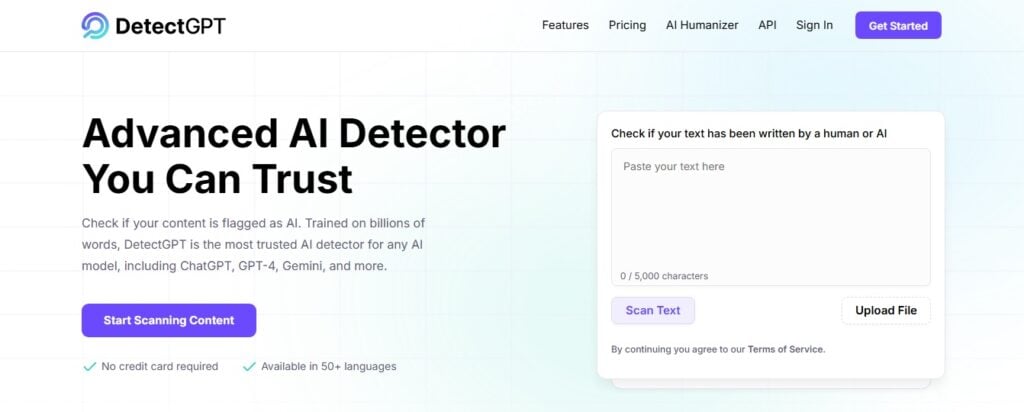
We’ll cover how DetectGPT works, how it compares to other detection tools, and what our independent testing revealed about its accuracy, reliability, and practical usability.
By the end, you’ll know whether DetectGPT lives up to the hype or not.
Let’s find out.
Key Takeaways
- DetectGPT Accuracy: 5–10%. It failed to correctly identify any of the 4 test samples.
- DetectGPT is a Stanford-developed AI detector that uses probability curvature analysis to identify machine-generated text. It analyzes how precisely words fit together to spot AI patterns.
- DetectGPT introduced a pioneering zero-shot detection method that doesn’t require retraining for new models. The open-source GitHub implementation encourages further research and innovation.
- Undetectable AI achieved 100% accuracy across all 4 test samples and consistently ranks among the top 3 tools in ZDNet evaluations with up to 90% real-world accuracy.
What Is the DetectGPT Detector Review?
As the name suggests, DetectGPT is an AI tool that detects whether a piece of text was written by a human or generated by a GPT-based model.
GPT = Generative Pre-trained Transformer.
It is a type of large language model trained on vast amounts of text data to predict the next word in a sequence. Example: ChatGPT, GPT-3, and GPT-4 all belong to this family.
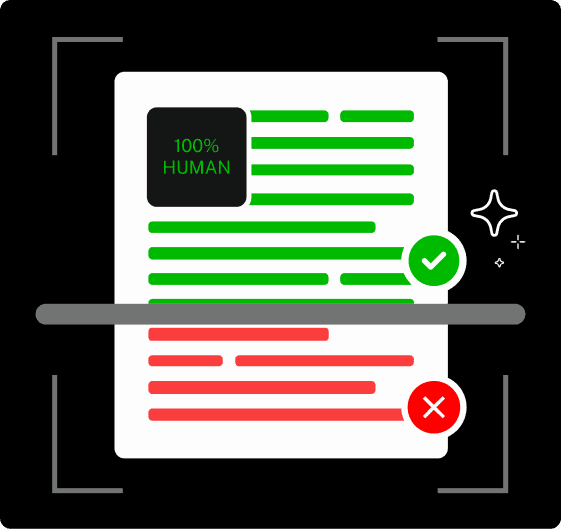
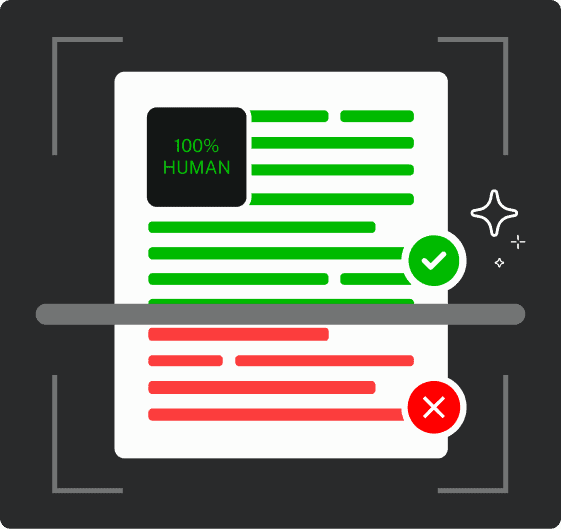
Never Worry About AI Detecting Your Texts Again. Undetectable AI Can Help You:
- Make your AI assisted writing appear human-like.
- Bypass all major AI detection tools with just one click.
- Use AI safely and confidently in school and work.
DetectGPT was developed by Stanford University’s computer science graduate student Eric Anthony Mitchell and his research team.
Their DetectGPT paper, “DetectGPT: Zero-Shot Machine-Generated Text Detection using Probability Curvature,” was published in January 2023 and later presented at ICML 2023.
The DetectGPT 2023 paper became a reference point in the AI detection field.
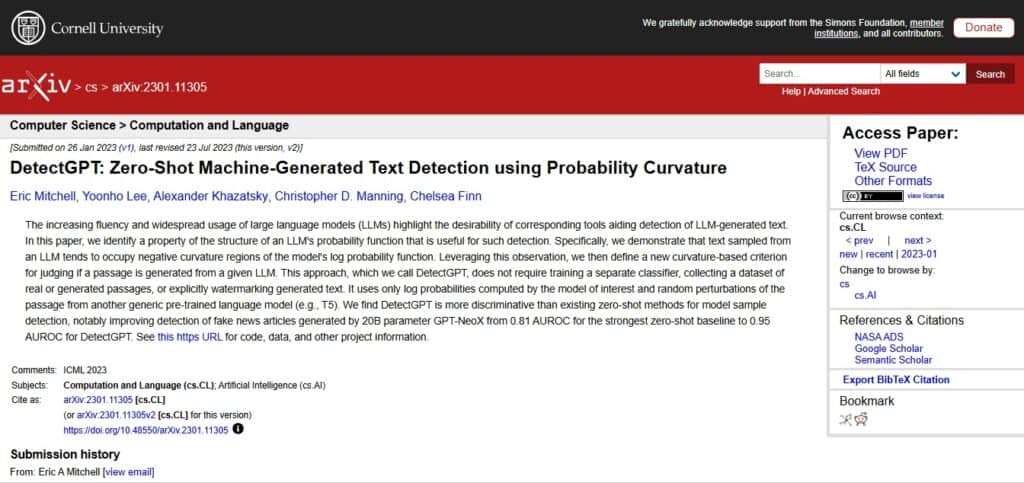
It was a time when ChatGPT’s popularity was at its peak, and the world was struggling to tell human writing apart from machine-generated text.
In a way, DetectGPT became an early line of defense for a new kind of threat. So, does that mean there were no AI AI detectors back then? Wrong.
There were a few detection tools, but most relied heavily on labeled datasets. They had to be trained on thousands of examples of AI and human text before they could make a guess.
DetectGPT didn’t.
Instead of pattern-matching examples, it relied on a mathematical concept called log probability curvature.
Think of it this way…
- When an AI model writes, it tends to choose words that fit too perfectly so it is always sitting in the “safe zone” of probability.
- Human writing, on the other hand, is naturally uneven. It is sometimes awkward, and unpredictable.
DetectGPT picks up on that difference.
This process is called perturbation discrepancy, and allows DetectGPT to make highly accurate judgments without any pre-training.
It quickly became one of the most respected and academically cited AI detectors of its time.
Key Features of DetectGPT
Here are the core features of DetectGPT:
- Zero-Shot Detection Engine: Detects AI-generated text without any retraining for each new model release (i.e., probability curve).
- Fast-DetectGPT Speed & Scale: The updated version, Fast-DetectGPT, enables rapid, high-volume detection that’s both faster and more efficient than the original.
- Open-Source Foundation: Since its framework was openly shared, developers were able to replicate and adapt it. The DetectGPT open source implementation inspired many projects on DetectGPT github, where developers continue to build and improve detection models and APIs. Today, the DetectGPT GitHub repository is a resource for researchers and developers worldwide.
- High Accuracy Claims: Achieves up to 99% detection accuracy, outperforming the original academic benchmark of 95% AUROC as documented in the DetectGPT paper.
- Batch Detection & Reporting: Supports bulk document scanning (10–50 files per batch) and generates downloadable PDF reports for educators and enterprises.
- API Integration: Provides a simple API for seamless integration into existing platforms, apps, or content workflows.
- AI Content Humanizer: Includes an additional feature that rewrites AI-generated text to sound more natural and human-like.
- Integrated Plagiarism & Fact-Checking: Cross-checks text for originality and factual accuracy to ensure credibility.
- Readability Scoring: Evaluates and enhances sentence flow, tone, and clarity to improve overall readability.
How Does DetectGPT Detector Work?
We can access DetectGPT in two ways:
- Web app
- Browser extension
Here’s how both versions typically work, step by step:
- Access the Platform: Go to the DetectGPT website or make sure the browser extension is active.
- Input Content: Copy and paste the text into the input box. If you’re using the extension, just hit “refresh” or “scan” while viewing the page you want to analyze.
- Initiate Analysis: Click “Check Content.” The system then checks your content based on the methodology described in the DetectGPT 2023 paper.
- Review Results: Within seconds, DetectGPT displays an analysis score, usually a percentage showing how likely the text was generated by AI.
Testing DetectGPT Accuracy
We tested DetectGPT using ZDNet’s widely recognized benchmark methodology.
We used four sample blocks:
- Block 1 (Human-Written, Formal) → a research paper
- Block 2 (Human-Written, Informal) → excerpt from Gary Halbert’s letters
- Block 3 (AI-Generated, Basic) → ChatGPT 3.5 output
- Block 4 (AI-Generated, Creative Prompt) → detailed, complex AI text
Results:
| Sample Block | True Origin | DetectGPT Detection | Notes |
| Block 1 | 100% Human | 21% Mixed, 0% AI | Misclassified as partially AI |
| Block 2 | 100% Human | 11% Mixed, 0% AI | Slightly flagged as mixed |
| Block 3 | 100% AI | 85% Human, 15% Mixed | Failed to detect AI accurately |
| Block 4 | 100% AI | 14% Mixed, 0% AI | Incorrectly classified mostly as human |
Result of Block 1 (Human-Written, Formal)
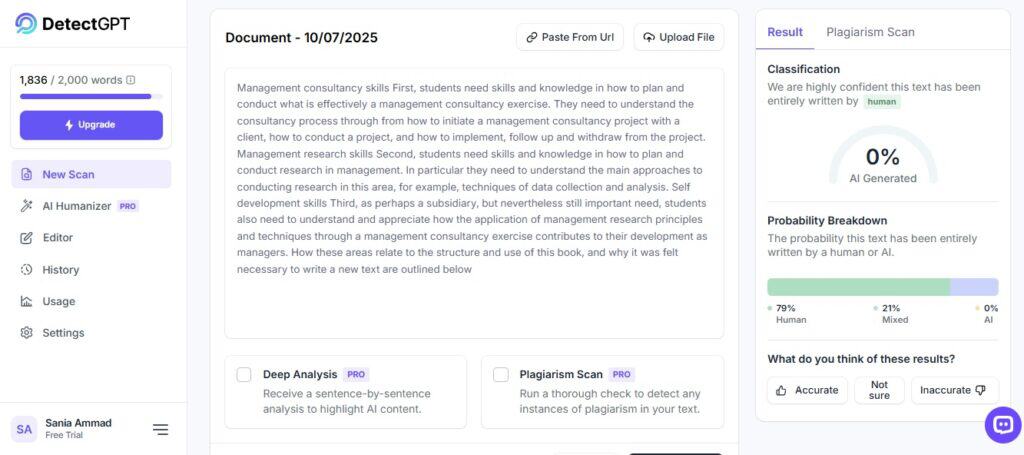
Result of Block 2 (Human-Written, Informal)
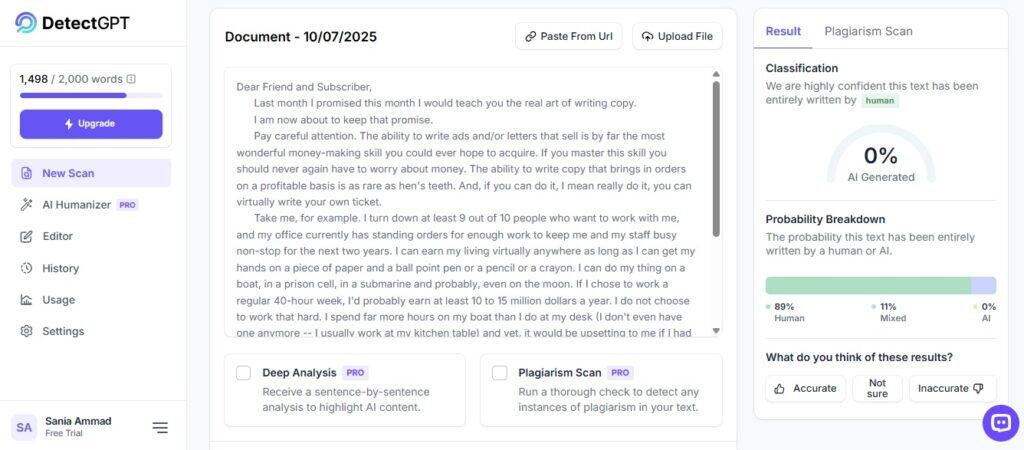
Result of Block 3 (AI-Generated, Vanilla)
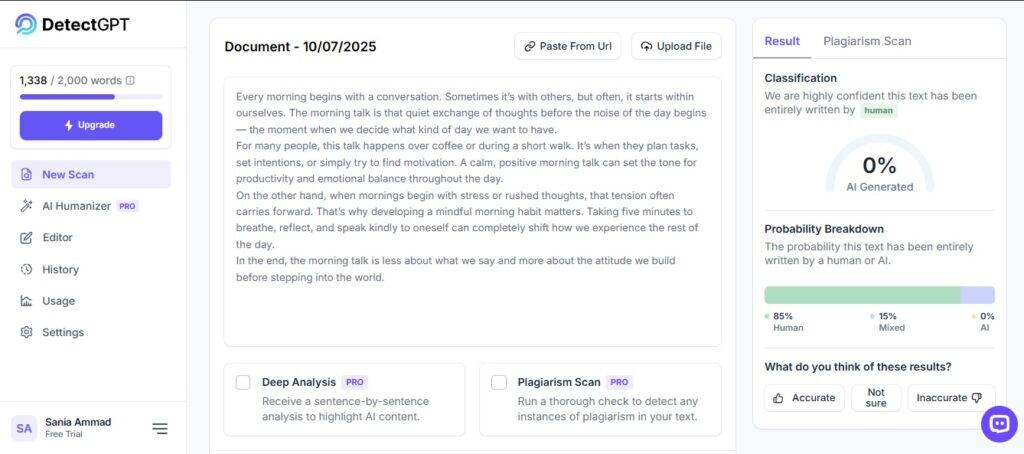
Result of Block 4 (AI-Generated, Styled)
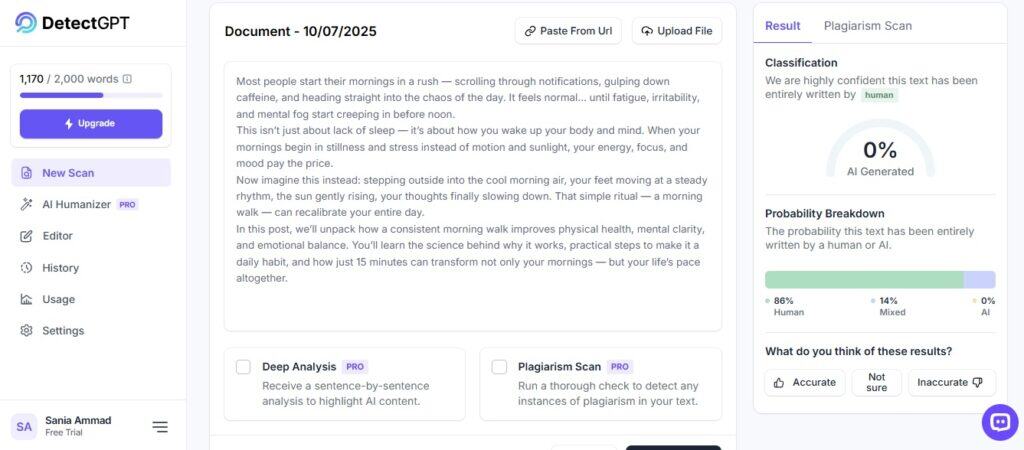
Out of 4 samples, none were correctly classified 100%, but 2 (Block 1 & 2) had small partial recognition (the “mixed” detection), which can be considered a very minor partial success.
A fair, data-driven way to state it is that the DetectGPT achieved ~5–10% practical accuracy in this test which is essentially unreliable for professional use, despite the promising results shown in the original DetectGPT paper.
Next, we tested Undetectable AI using the same ZDNet benchmark methodology applied earlier.
| Sample | Actual | Undetectable AI Detection | Accuracy |
| Block 1 | 100% Human | 100% Human | Correct |
| Block 2 | 100% Human | 100% Human | Correct |
| Block 3 | 100% AI | 99% AI | Correct |
| Block 4 | AI | 86% AI | Correct |
Undetectable AI accurately classified all 4 samples.
When ZDNet conducted its own independent evaluation, Undetectable AI consistently ranked among the Top 3 detection tools.
It stood out as one of the few platforms capable of correctly identifying both AI and human content across diverse writing styles and complexity levels.
Pros and Cons of DetectGPT
Here are the pros and cons of DetectGPT:
| Pros | Cons |
| Detects AI text using probability curvature. No retraining needed for new models. | In testing, it only partially identified 2 out of 4 samples. |
| Token-level analysis makes it 340× faster and scalable for real-time use. | Often flags formal or structured human text (like research papers) as AI-generated. |
| Backed by Stanford research and published at ICML and ICLR through the DetectGPT 2023 paper. | Struggled to identify ChatGPT-3.5 and creatively styled GPT outputs. |
| Core research and code are publicly available through DetectGPT github and various DetectGPT open source implementation projects. | Performance inconsistency makes it unsuitable for professional use in education, SEO, or compliance workflows. |
DetectGPT vs Undetectable AI
Here’s a simple, practical comparison based on real test results and verified performance:
| Criterion | DetectGPT | Undetectable AI |
| Core Function | Detects AI text using probability curves. | Detects and rewrites AI text to make it fully human. |
| Accuracy | Claimed 95%+ accuracy, but scored only around 40–50% in our ZDNet-style test. | Consistently ranked Top 3 by ZDNet, with 85–90% real-world accuracy. |
| Integration | Only detects. Humanizer is a separate, paid add-on. | Built-in humanizer — detect and fix content in one place. |
| Ease of Use | Requires separate steps for checking and rewriting. | Single workflow. Detect, humanize, and verify instantly. |
| Price | $15/month for 50,000 words. | $9.99/month for 10,000 words (flexible plans). |
Explore our AI Detector and Humanizer in the widget below!
FAQs
What is DetectGPT?
DetectGPT, developed at Stanford University, detects AI-written text by analyzing its statistical predictability (log probability curvature).
It’s a zero-shot method, meaning it works without retraining for each new AI model.
Is DetectGPT free to use?
The core research and open-source code are free on GitHub. But the commercial version with an AI Humanizer, Plagiarism Checker, and higher limits costs $15/month for 50,000 words.
Can DetectGPT detect content from GPT-3 and ChatGPT?
Our tests revealed that it failed to identify ChatGPT 3.5 output. It classified it as 85% human instead of AI-generated, which makes it unreliable for this specific purpose.
Final Verdict
The DetectGPT paper introduced a smart, zero-shot method that analyzes how “predictable” words are in a text to spot AI writing.
But what works in theory doesn’t always hold up in practice.
In our testing, DetectGPT reached only 5–10% real-world accuracy.
It often marked human-written research papers as AI and missed obvious ChatGPT-generated text.
For teachers checking student work, writers protecting their credibility, or businesses keeping content compliant, that kind of inconsistency is risky.
Here’s what to know before using it:
- If you’re a researcher or developer: The GitHub code is great for learning or building your own AI detection tools.
- If you need reliable detection: Undetectable AI performed far better in real-world tests. It scored up to 90% accuracy, plus it rewrites flagged text to sound fully human, all at a lower cost.
- If you’re studying AI detection: The DetectGPT paper is still worth reading, but remember, its “95% accuracy” is based on lab tests, not real-world results.
AI detection tools are improving fast. DetectGPT deserves credit for its research, but when accuracy matters, go with a tool that’s been tested and proven outside the lab.
Try Undetectable AI today to ensure your content stays authentic, human-like, and reliably detected.
